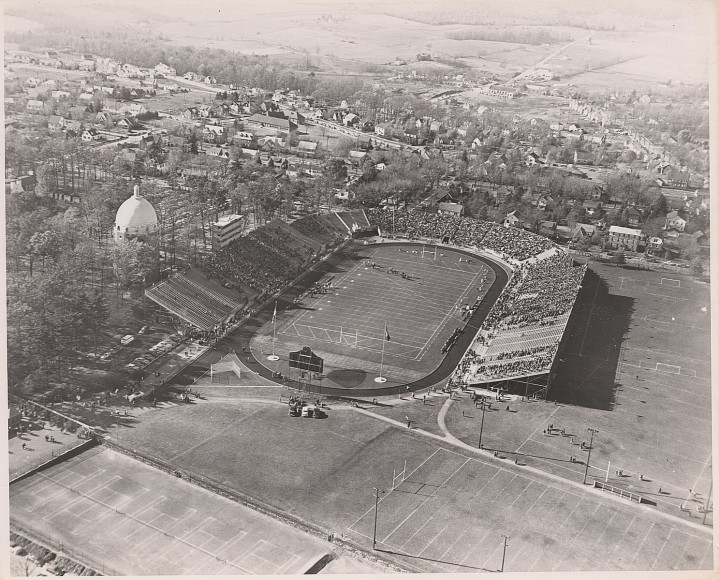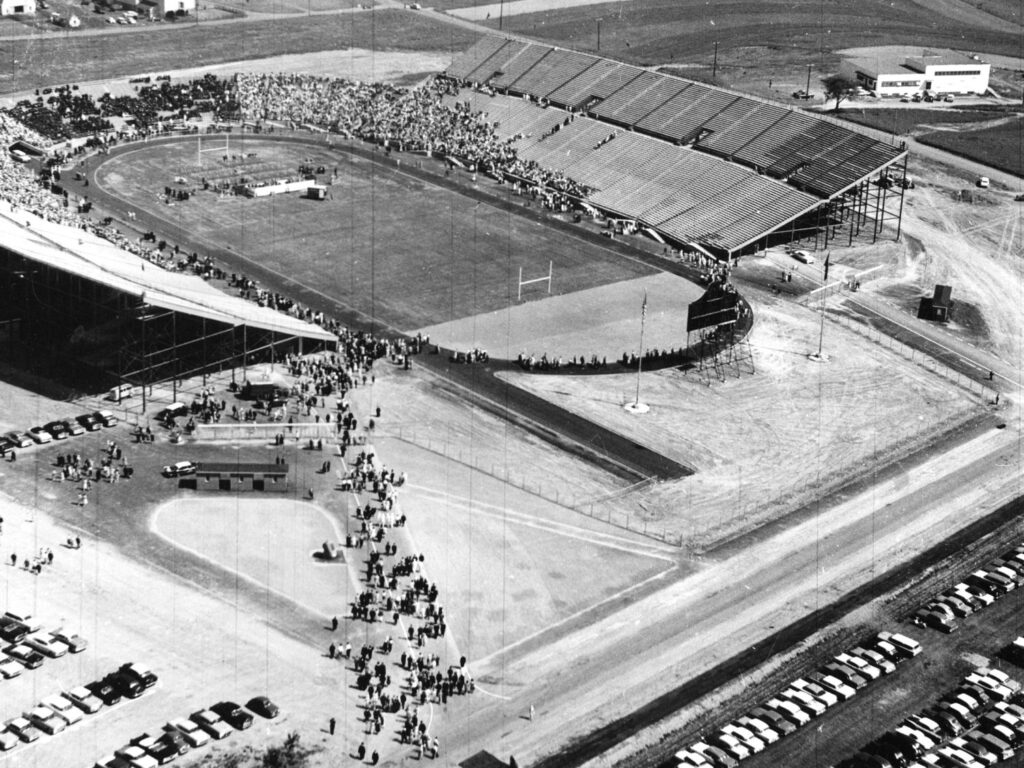Beaver Stadium, the home of Penn State football, provides a venue for the passionate connection of students, alumni, and fans to the University and the communal experience of a football Saturday.
With its 106,572-seat capacity, Beaver Stadium is the second-largest stadium in the United States. Penn State football plays a major role in the economy of Centre County as well, bringing thousands of fans to State College to patronize stores, restaurants, and hotels on seven Saturdays a year.
Penn State football began the fall 1960 season in its current location, with a capacity of 43,989 seats. There have been three major enlargements of Beaver Stadium, along with incremental additions, since then. The stadium grew to 76,017 between the 1977 and 1978 seasons by cutting the steel grandstand into segments, jacking them up 12.5 feet and placing new concrete stands below the existing steel stands. The concrete stands were also continued around the open, south end, making the stadium a bowl.

Then, in 1990-91, a steel and concrete deck containing 10,597 new seats was added above the north endzone. Finally, two decks of concrete stands, with an enclosed club level, were added above the south endzone, and three rows of luxury boxes added above the stands on the east side in 1999-2001. This brought the stadium to today’s capacity of approximately 107,000.
Football, as an intercollegiate sport, began at Penn State in 1887, with its first home game played versus Bucknell University. Traditionally, that first home game is believed to have been played on the lawn in front of Old Main. However, the faculty had designated a space to the northeast of Old Main as a playing field as early as 1875, although it was unimproved and frequently unusable as a playing field.
In 1891 and 1893, thanks to the efforts of Governor James A. Beaver, legislative appropriations totaling $3,000 were secured to lay out the grounds and build a 500-seat covered grandstand for the field, which was also used for baseball and track. Because of the key role the governor played, the student body asked the Board of Trustees to name it Beaver Field in his honor, and the board concurred.
Old Beaver Field (as it was later called) occupied the center of campus, surrounded by the few academic buildings and faculty cottages, and it served the college well between 1893 and 1909. By the turn of the century, Penn State was adding new academic programs; its enrollment surpassed 1,000 students and was continuing to grow. In 1908, the first campus master plan was created.
The central campus was designated for academics and a new athletics district was planned for the northwest corner. It would include spaces for football and track, baseball with its own field, fields for soccer and lacrosse, tennis courts, and support buildings for indoor training and locker facilities. Eventually a new gymnasium (Rec Hall), the college golf course, an athletic dormitory, the Nittany Lion Inn, and the Nittany Lion statue would also be built in this precinct.
The wooden grandstand from the original field was moved and rebuilt on the west side of the new football field. The name Beaver Field was retained, although it eventually became popularly known as New Beaver Field. As at the original location, track and field competitions were also hosted here.
As the football team increased its success and popularity, more permanent wooden grandstands were added. Homecoming games, added in the 1920 season, could attract as many as 20,000 fans, with temporary wooden bleachers turning the grandstands into a bowl.
By the mid-1930s, the wooden grandstands were gradually replaced with steel stands. Four segments were added over five years using a patented steel grandstand construction process that allowed additional segments to be bolted onto the existing stands.

The east and west stands were joined in a horseshoe configuration in 1948-49, bringing the capacity of New Beaver Field to 27,720. By the end of the 1950s, the academic needs of a growing campus again forced the relocation of all the athletic fields, this time to the open pastures of the east campus, beyond the newly-constructed University Drive.
Between the 1959 and 1960 seasons, the existing New Beaver Field grandstands were taken apart, trucked to the new location, reassembled, and added to 16,269 new seats already built on the site. This unusual construction method enabled Penn State to economically increase seating capacity for football games as demand required, as it had since the wooden grandstand days.
Both the Old and New Beaver Field locations on central campus allowed students to easily walk from nearby dormitories, fraternities, and rooming houses in town to football games, when relatively few fans came from a distance. By the 1950s, more alumni and fans were driving longer distances to games and the new stadium, surrounded by empty fields, made parking for thousands of cars, buses and later RVs possible, and created the tailgating traditions of home football Saturdays.
While it appeared the stadium capacity was as large as would ever be needed for Penn State’s football program, Beaver Stadium was an aging structure with a number of shortcomings. In 2009, plans were developed for a renovated west side with new press box, suites and other improvements. However, in late 2011, the sexual abuse scandal forced the plan to be set aside.
But, by 2015, a comprehensive master planning effort for athletic facilities was begun, including the possible renovation or replacement of Beaver Stadium. The idea of replacing the beloved stadium struck a nerve with many Nittany Lion supporters, and while many other athletics facilities needed attention, the stadium’s future held the primary interest of most fans.
After a lengthy period of planning, the university announced in February, 2023, it would recommend a multi-phased renovation plan to the Board of Trustees instead of replacement. As a more economical solution, it would include upgraded amenities and circulation and envisioned expanded use beyond football. Two months later, the board approved the estimated $700 million project which would dramatically change the west side of the stadium over four years and include a welcome center for the university, new luxury seating, club areas and boxes, and the creation of new media facilities.
The project began with the explosive demolition of the press box on January 4, 2025, and continues with removal of the upper rows of steel stands above the existing concourse, followed by new construction. With much of the work being done between seasons, the west side renovation is planned for completion by the start of the fall 2027 football season.
Lee Stout
Source:
Stout, Lee and Harry H. West. Lair of the Lion: A History of Beaver Stadium. University Park: Keystone Books, 2017.
First Published: March 10, 2021
Last Modified: March 5, 2025
